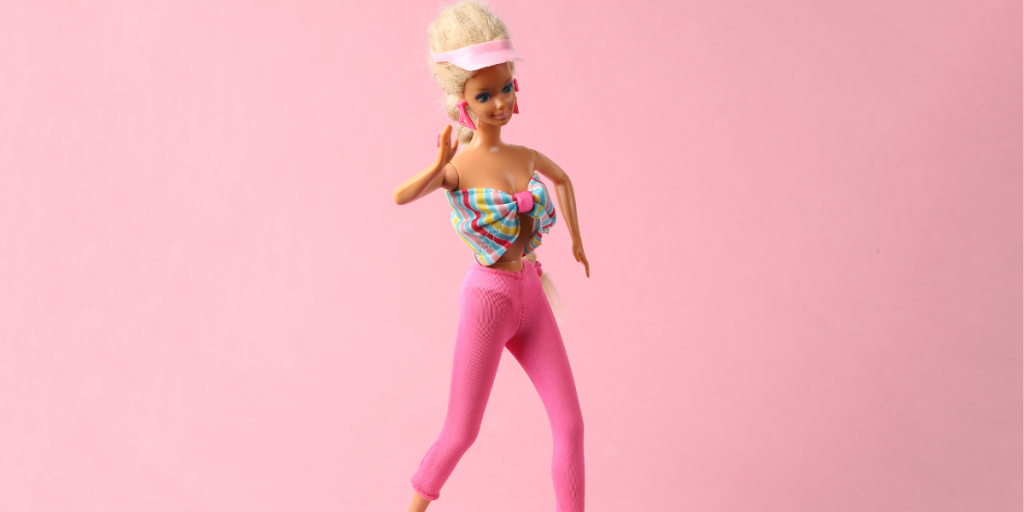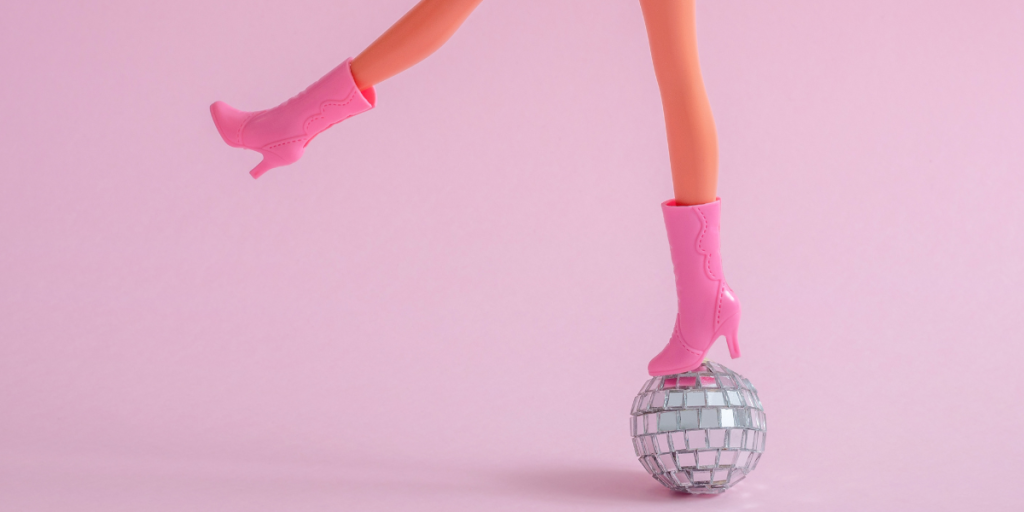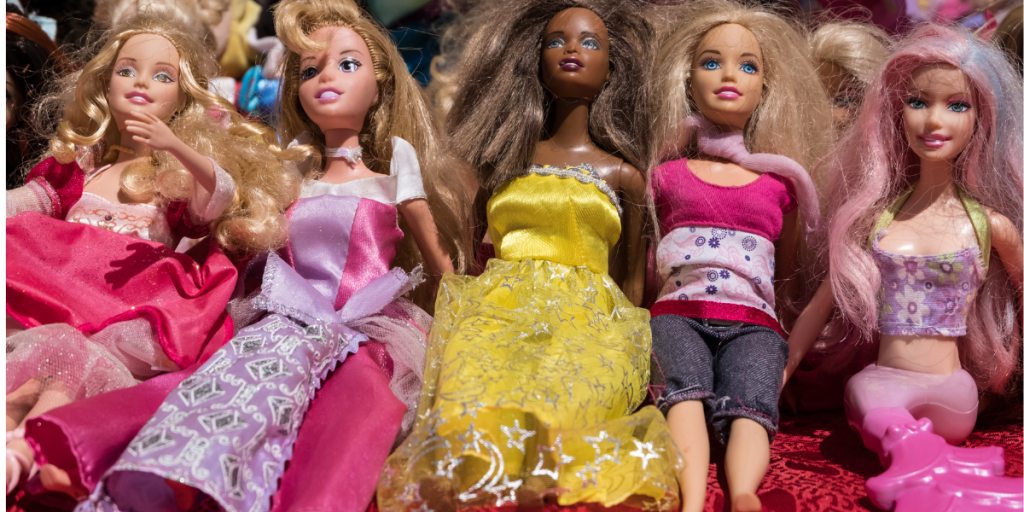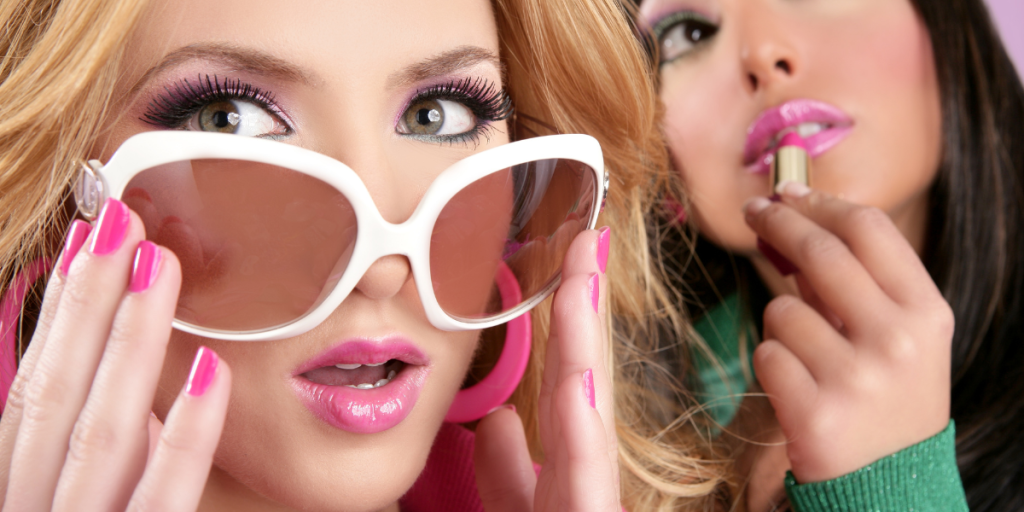She’s long, lean, and smothered in pink. Her hair is beauty-pageant lush, her plastic breasts are firmly attentive, and her non-bunioned feet are always on tiptoe. And she has it all – careers, houses, cars, fashion, friends. It’s no wonder her smiling eyes sparkle with “my life is perfect ” unreality – an unreality that actually has its own name: Barbie Doll Syndrome.

You know the aesthetic: tall, thin, blonde, cis white female with an impossibly cinched waist and legs for days. And don’t forget the Carrie Bradshaw closetful of couture.
Since coming out of the box in 1959, Barbie has maintained one of the most iconic bodies and brands in the world. Her brand recognition is up there with Mickey Mouse, though for very different reasons.
Considering that 88% of women had a Barbie doll growing up, Barbie’s influence on how we feel about our bodies is undeniable.

(And then there’s Ken, Barbie’s industry-imposed male-of-interest who just couldn’t – and still can’t – shine outside of Barbie’s orbit. But that’s another article.)
All toying aside, Barbie is more than just a thin plastic doll. She brings in over $1 billion in annual sales across more than 150 countries. And she has sashayed into the clutches and Dream Houses of 92% of American girls ages 3 to 12.
Barbie Doll as Influencer: The birth of an obsession
M.G. Lord, a Barbie biographer, believes Barbie was designed “to teach women what – for better or worse – is expected of them in society.”
She credits Barbie as being a global symbol of classic American beauty – to the point of 39-18-33 original measurements.
Believe it or not, Barbie’s physical appearance wasn’t conceived in mid-century American feminine ideals. It was modeled on the German Bild Lilli doll, a risqué gag gift for men based on a cartoon character featured in a West German newspaper.
Gag gift or not, the fantasy, if not sexualized, model of the female body a la Barbie is a fixture of body-image discussion.
And it’s the preoccupation with this plasticized ideal – her look, her accolades, her lifestyle – that has earned the label Barbie Doll Syndrome.
This fixation on an unattainable ideal of beauty and perfection underlies a specific body dysmorphic condition and can lead to dangerous eating disorders.
It can also lead to an obsession with plastic surgery in order to attain what is physically impossible.
Despite the much-disputed psychological messaging of Barbie’s physicality, she came with a novel purpose that has carried through to this day.
She represented the limitless potential of every girl, with or without matrimony, motherhood, or a life as a homemaker. She was educated (she uttered her first words – “Let’s go shopping!” – at age 9), and her resumé outshined Ken’s.
Of course it did.
So, when we talk about Barbie Doll Syndrome, there are certainly ideals and mindsets worth emulating.
But there are also ones worth keeping in close check, if not discarding altogether.
For example, while Barbie tampered with social consciousness by introducing an African-American friend in the late ‘60’s, the new doll still had Eurocentric features.
Then came chill Malibu Barbie (with her own Dream House) in the early ‘70’s, all tan and California-esque.
Again, the cultural ideal body image of a thin, white cis female remained.
Barbie Doll Syndrome and body image: Setting the stage

Let’s take a stroll down Barbie Lane and take note of Barbie’s iterations over the decades.
For me, nothing compared to the Barbie Beauty Center in the 1970’s. You could brush and style Barbie’s long blonde locks of hair as her oversized head remained perched on a stand.
Also debuting in the 1970’s was Barbie’s chic townhouse, with its oh-so-modern-appeal.
I remember glam Barbie and Ken in the late 1970’s, with their matching bathing suits.
In the 1980’s, Barbie updated her townhouse and became friends with Hispanic Barbie.
In all versions of herself, her Barbie body remained indisputable.

But does that really matter? Can a relatively unchanged doll from 1959 really affect body image in 2023?
What is the relationship between Barbie Doll Syndrome and body image in the here and now?
Let’s continue to look at Barbie’s evolution before talking about the modern-day impact on body image.
Barbie became an astronaut in the mid 1980’s, and, in her form-fitting, very pink astronaut suit, even landed on the moon.
She then became a medical doctor the following year, complete with a stethoscope and white jacket over her tight-fitting pink pantsuit.
Barbie updated her abode (“Dream House”) in 1990 and shortly after debuted as an aviator in the Air Force.
In 1997, she and adoring Ken became thespians.
In 1998 her Dream House became “Deluxe” (with green added to her pink decor).
And, in the new millennium, she has become an art teacher, cooking show host, and equestrian, all while donning her signature perfect blonde hair and svelte figure.
After working as an engineer, Barbie decided to become an architect so she could build her own Dream House.
She had a smartphone in 2013 and moveable body parts in 2015.
In 2016, she became super-progressive. Ready for this? She became “curvy.”
Barbie was no longer as thin, and her proportions were no longer prohibitive to walking upright if she were a real person.
That same year, she was part of a collection with 6 different body types, 9 skin tones, 6 eye colors, 11 hair colors, and 10 hairstyles. (Sorry, Mattel. This doesn’t really count as “body positivity.”)
In the early 2020’s, Barbie was part of the Fashionista line. The line includes friends with Down’s Syndrome, a prosthetic limb, and no hair.
Supposedly Mattel sold the more diverse Barbies as part of a collection so that no one would be offended if given a singular curvy or disabled Barbie. Hmmm.

The message is clear: Customers will less likely be offended if they receive an ‘atypical’ Barbie as part of a collection than if they receive the atypical Barbie by itself.
So that is Barbie.
The most common theme in all her iterations is a thin physique, stylish blonde hair, and glamorous clothing and accessories.
Is Barbie all bad?
Not entirely.

In 2021, researchers found that kids talked more about others’ thoughts and emotions when playing with dolls than while playing on a tablet.
Speaking about others’ internal states is known as internal state language (ISL). ISL leads to practicing social skills when interacting with people in real life and benefits emotional development.
Sounds positive, right? So what’s the concern?
Going for gold: Quintessential Barbie and body image
In the 1960’s a version of Barbie debuted that says it all.
Slumber Party Barbie arrived on the scene, with a scale permanently landing at 110 lbs.
Included was a book titled How To Lose Weight.
There were only two words in the book, all in capital letters: “DON’T EAT!”
Many years later, the guidance of not eating re-emerged as “I.D.E.A.” The code word, used online by eating disorder sufferers, is short for “I don’t eat anymore.” (Social media can be outright dangerous.)
Our exposure to highly unrealistic images of the female body begins early. And the message is clear: To be successful, you must have a Barbie body IRL.
As Kim Culmone, Mattel’s Head of Design says, Barbie dolls are “… a personal issue because almost every woman has owned a Barbie, and every woman has some relationship with or opinion about Barbie.”

The prototypic Barbie doll, by the way, is stated to be 5’9″ tall and weigh in the low 100s.
She is far too low in body weight to even menstruate, let alone become pregnant.
The Yale Center for Eating and Weight Disorders calculated how much an average woman’s body would have to change in order for her to have the proportions of Barbie’s body.
To have a Barbie body, women on average would have to grow 2 feet taller, extend neck length by 3.2 inches (to hold up their heads), gain 5 inches in chest size, and lose 6 inches in waist circumference. They wouldn’t have room in their bodies for a full liver or full intestines.
No woman could ever achieve such impossible dimensions. Yet, girls are encouraged (subtly and overtly) to have a Barbie body.

In other words, although Barbie isn’t real or even realistic, Barbie Doll Syndrome is very real. And real girls and women have diminished self-images and distorted eating habits because of it.
Researchers studied girls aged 5 to 8. They showed the subjects images of either a Barbie doll or a more realistic (size 16) doll.
Those who saw the Barbie dolls had lower self-esteem and body image, and their drive to be thin was stronger.
When girls aged 6 to 10 were assigned to play with either a thin doll or an average-sized doll, the children who played with the thin doll ate significantly less food.
The bodies represented by the popular dolls – “the toy that every girl must have” – directly influenced how children saw themselves and fed themselves.
In a 2023 study of 1000 women, 82% believed Barbie portrays an unrealistic body ideal to girls and women.
The body parts women compare are waist (42%), legs (34%), hair (28%), chest (27%), and face (26%).
Three in 5 women say that recent Barbies are better at reflecting body diversity than previous dolls. But 69% still think Barbies can lead to body image issues.
In their 2023 report, Harmony Healthcare found that 80% of women reported negative body image, and 27% indicated their negative body image began at age 10 or younger.
According to Mattel, it’s not Barbie who worsens girls’ body image, but models and moms.
In reality, Barbie is far from the average woman.
Even though Mattel now makes Barbie dolls of different sizes (original, curvy, tall, and petite), hairstyles, and skin tones, the dolls are still body-image downers. (Their website indicates they currently have “35 skin tones, 97 hairstyles, and 9 body types.”)
No matter. It still took almost 60 years to make Barbie, the American iconic doll, anything but thin. And girls’ and women’s body-image concerns are still rampant.
At least for now.
Dr. Elayne Daniels is an international coach, consultant, and psychologist. She’s helped hundreds of people with body image concerns. To learn more about how she can help you, contact her here.
To read more about Body Image, check out some blog articles.
